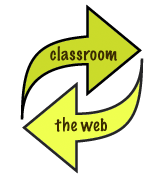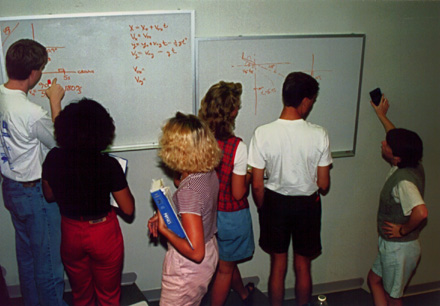| Learning technologies should be designed
to increase, and not to reduce, the amount of personal contact between students
and faculty on intellectual issues. |
(Study Group on the Conditions of Excellence in American Higher Education, 1984) |
What is Just-in-Time Teaching? | G. Novak, gnovak@iupui.edu |
For detailed examples of the JiTT web resources, please see the JiTT resources page.
WarmUps and Puzzles are the heart of the JiTT web component. These are short, web-based assignments, prompting the student to think about the upcoming lesson and
 answer a few simple questions prior to class. These questions, when fully discussed, often have complex answers. The students are expected to develop the answer as far as they can on their own. We finish the job in the classroom. These assignments are due just a few hours before class time. The responses are delivered to the instructor electronically to form the framework for the classroom activities that follow. Typically, the instructors duplicates sample responses on transparencies and takes them to class. The interactive classroom session, built around these responses, replaces the traditional lecture/recitation format.
answer a few simple questions prior to class. These questions, when fully discussed, often have complex answers. The students are expected to develop the answer as far as they can on their own. We finish the job in the classroom. These assignments are due just a few hours before class time. The responses are delivered to the instructor electronically to form the framework for the classroom activities that follow. Typically, the instructors duplicates sample responses on transparencies and takes them to class. The interactive classroom session, built around these responses, replaces the traditional lecture/recitation format.
Students complete the WarmUp assignments before they receive any formal instruction on a particular topic. They earn credit for answering a question, substantiated by prior knowledge and whatever they managed to glean from the textbook. The answers do not have to be complete, or even correct. In fact, partially correct responses are particularly useful as classroom discussion fodder. In contrast to WarmUps, Puzzle exercises are assigned to students after they have received formal instruction on a particular topic. The Puzzles serve as the framework for a wrap-up session on a particular topic.
The WarmUps, and to some extent the Puzzles, are undergirded by education research and target a variety of specific issues. The list of targeted issues might contain: developing concepts and vocabulary, modeling -- connecting concepts and equations, estimation- getting a feel for magnitudes, relating technical scientific statements to "common sense", understanding the scope of applicability of equations, etc. The targeted issues are highly content specific. They may involve the characteristics of a particular class (e.g. the background skills of a particular student body).
In preparing WarmUp assignments for an upcoming class meeting, we first create a conceptual outline of the lesson content. This task is similar to the preparation of a traditional passive lecture. As we work on the outline, we pay attention to the pedagogical issues that we need to focus on when in the classroom. Are we introducing new concepts and/or new notation? Are we building on a previous lesson, and if so, what bears repeating? What are the important points we wish the students to remember from the session? What are the common difficulties typical students will face when exposed to this material? (Previous classroom experience and teaching and learning literature can be immensely helpful here). Once this outline has been created, we create broadly based questions that will force students to grapple with as many of the issues as possible. We are hoping to receive, in the student responses, the framework on which we build the in-class experience.

*Astin, Alexander: What matters in college? Four critical years revisited (San Francisco, CA: Jossey-Bass Publishers, 1993).